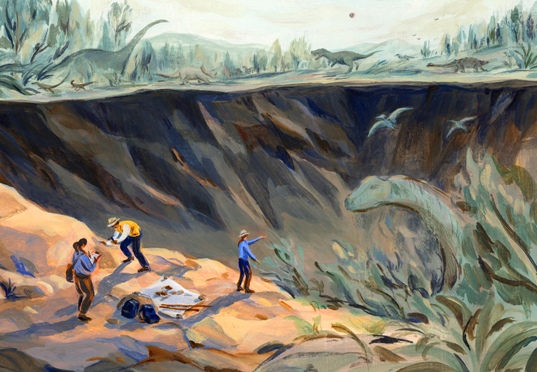The rock that ended the dinosaurs was much more than a Dino killer
By Becky Ferreira
The first cave art. The dawn of agriculture. Although these are among the most crucial moments in humankind’s beginnings, our most dramatic origin story starts 66 million years ago. It was the apocalyptic instant when a rock from outer space slammed into Earth, terminating the age of dinosaurs and eventually offering a bountiful new world to our mammalian ancestors.
For 40 years, scientists have studied the tale of this catastrophic object, known now as the Chicxulub impactor. Today, the impactor represents more than just one bad day on Earth; instead, it has become a kind of Rosetta Stone that can decipher deeper riddles about the origins of life and the future of human civilization, both on our planet and in other worlds across the galaxy.
“The Chicxulub impact event completely modified the geologic and biologic evolution of planet Earth,” said David Kring, a planetary geologist who leads the Centre for Lunar Science and Exploration in Houston and who was part of the team that announced the discovery of the Chicxulub impact crater beneath Mexico’s Yucatán Peninsula in 1991. “That is such a big scientific story with popular appeal because it extinguished dinosaurs and cleared the slate, if you will, for mammalian evolution that led to humans, it’s going to captivate both the scientific community and the public for years to come.”
For decades, scientists argued about the cause of the dinosaurs’ deaths. Volcanic eruptions and other exotic hypotheses were proposed, but the scientific consensus settled on a rock from space being the killer. The Chicxulub theory now reigns so supreme that scientists have pieced together detailed timelines of what transpired on that fateful day, and other researchers are writing what could be called the prequel, seeking the extraterrestrial origins of the event to which we partially owe our existence.
As more advanced tools and techniques become available, scientists have been able to extract new and precise insights about this epic wipe-out on our planet, and what it may mean for the beginnings of life itself.
The latest find comes from a study published in July in the journal Icarus that sought the original home of the Chicxulub impactor. It did this by leveraging the immense processing power of a NASA supercomputer to model the motions of roughly 130,000 asteroids in the main belt between the orbits of Mars and Jupiter.
“Ultimately, we want to solve big questions, and this kind of work allows us to get after some of them,” said Bill Bottke, co-author of the study and director of the department of space studies at the Southwest Research Institute in Boulder, Colorado.
The Icarus study is part of a constant stream of ideas about the impact that can be dazzling in their creativity, often to the point of controversy. This year, for instance, a Harvard University team revived the possibility that the impactor was a comet, sparking pushback from many scientists in the field.
Bottke said access to NASA’s Pleiades supercomputer was a “game-changer” for his team, enabling the researchers to run simulations of a huge asteroid population over the course of hundreds of millions of years.
This Big Data technique helped to match the strong geological evidence that the impactor was a carbonaceous asteroid — and not a comet — with a possible origin in the outer asteroid belt. This distant region between Mars and Jupiter contains many miles-wide carbonaceous asteroids similar to the Chicxulub impactor. But these rocks aren’t gravitationally hoisted into collision courses with planets as frequently as asteroids in the inner region of the belt, where there are fewer objects that match Chicxulub’s composition.
“We were not finding an obvious solution to where one of the largest impactors that has hit Earth over recent time came from,” Bottke said. “Essentially, a lot of the possibilities we had tried just weren’t panning out. It was really frustrating and it seemed like we were missing something.”
The team’s supercomputer approach revealed that Chicxulub-like asteroids escape from the outer belt about 10 times more frequently than implied by previous models. That boosts the odds that the dinosaur-killing rock may have originated there.
“This is confirmation of a really cool idea, and I think it helps me understand a lot more about how the asteroid belt may be influencing the Earth over billions of years,” Bottke said.
Sean Gulick, a planetary geophysicist at the University of Texas at Austin who was one of the leaders of a 2016 scientific drilling expedition that obtained precious rock cores from the Chicxulub crater, said the paper was an interesting approach to performing “the forensics, if you will, about where the impactor came from. It’s intriguing because it was such an important event for the evolution of our planet and ourselves.”
The mission Gulick helped lead continues to clarify the impact’s role as both a destroyer and a crucible of life. As the researchers plumbed the depths of the buried doomsday event, they found dusty traces of the impactor, sandy backwash from the tsunami it had created and the fossilized remains of organisms that thrived in its aftermath.
Perhaps most astonishing, a study published this summer described modern-day microbial descendants of those early crater adopters, still living in the shadow of the catastrophe that was colonized by their forebears.
“It’s amazing to me that you can have an impact and you can generate an ecosystem, then 66 million years later, you still have life that is present in that location because of this previous condition,” Gulick said. “On a bigger scale, maybe you can generate habitats with impacts really early in Earth’s history and have ecosystems survive afterward. That reflects one of the ways in which you might get life going.”
-New York Times


